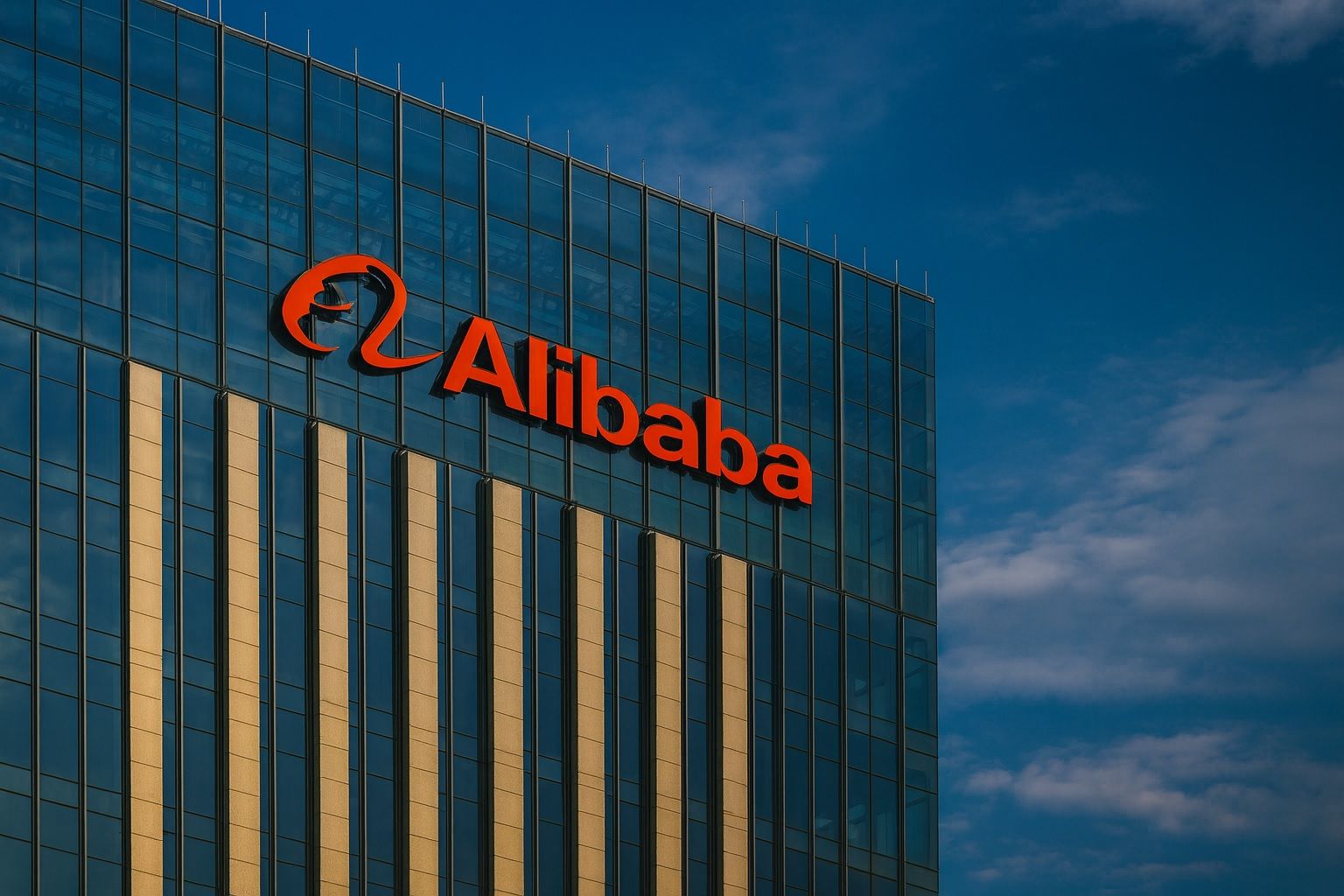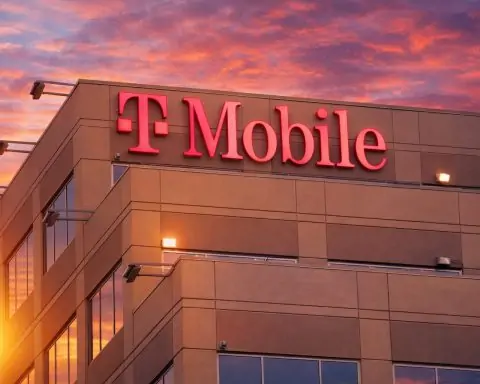- Dramatic Rally: Alibaba’s U.S.-listed shares (NYSE: BABA) recently jumped about 8% in one day (Sept 24, 2025) to ~$176 – a four-year high – and are up roughly 85–90% year-to-date [1] [2]. Its Hong Kong listing (09988.HK) similarly hit multi-year highs (~HK$171.50) on the same news [3].
- Cloud Boom: In the latest quarter, Alibaba Cloud revenue surged ~26% year-over-year (beating ~18% consensus), driven by AI demand [4] [5]. By contrast, retail (China commerce) grew more modestly (~10%) [6]. Overall revenue growth has been modest (CMB predicts ~2% YoY for Q2 FY2026) [7].
- Margins Under Pressure: Heavy investment in new ventures (AI, “quick-commerce” delivery, etc.) has cut into profitability. Adjusted operating profit (EBITA) fell ~14% last quarter [8], as Alibaba spent on user acquisition and cloud infra (“profitability was impacted by growth initiatives” [9]).
- Analyst Optimism: Wall Street sentiment is broadly bullish. 15 of 16 analysts rate BABA a Buy (0 Sell ratings) [10]. The consensus 12-month price target is around $192 [11] (implying modest upside), but many top targets range $190–$240. For example, JPMorgan maintains an “Overweight” stance with a ~$240 target [12], Nomura raised its ADR target to $215 (Buy) [13], and Bank of America to ~$195 [14].
- Strategic Pivot to AI: CEO Eddie Wu has declared that AI development is “far beyond expectations,” and Alibaba is “all-in” on AI, expanding its original ¥380 billion plan (US$53B) for AI/cloud investment [15]. At its Sept. 24 Apsara conference, Alibaba unveiled the 1-trillion-parameter Qwen3-Max AI model and new AI services (e.g. multimodal Qwen3-Omni) [16], and announced NVIDIA partnerships and overseas data centers [17] [18].
- Regulatory Climate Cooling: The worst of China’s tech crackdown appears behind. (Alibaba paid a record $2.8B antitrust fine in 2021, and “pick one from two” probes ended in 2024.) Recent regulatory news has been mild. In early Oct., the Cyberspace Administration briefly summoned Alibaba’s UC Browser unit over content issues, but the stock actually rose on that news [19].
Recent Stock Performance
Alibaba’s stock has been on a tear in 2025. In the U.S., BABA’s ADR climbed from around $90 in early 2025 to the mid-$170s by late Sept., roughly doubling off its spring lows [20]. The rally accelerated after CEO Wu’s Sept. 24 AI announcement, which sent BABA up nearly 8% in one session [21]. Likewise in Hong Kong, the “BABA-W” shares jumped over 7% (to ~HK$171.50) on that day [22]. By comparison, major indices lagged: the NYSE Composite was only up ~12% in 2025 [23].
This momentum carried Alibaba above several technical resistances, with Benzinga noting a “favorable price trend in the short, medium and long terms” [24]. Short-term indicators like RSI are in overbought territory (one analysis flags RSI>70), but trend-followers remain bullish, expecting new highs [25] [26]. The stock’s 50-day and 200-day moving averages have climbed sharply (mid-$140s and ~$127 respectively [27]), reflecting the uptrend.
There have been small pullbacks amid broader market swings. For example, on Oct. 8, U.S. tech stocks slipped on AI “bubble” concerns, and Alibaba fell about 1.6% in Hong Kong (to ~HK$177.60) [28]. Nonetheless, these dips appear to be shallow. In fact, BABA shares remain well above 2024 lows (~$80) and have largely held up during recent market jitters. Overall, 2025’s uptrend in Alibaba stock has been much stronger than China’s economy (retail sales up only ~3–4% in Aug.) or the Hang Seng Index (which was down ~1–2% in early Oct.) [29] [30].
Latest News and Catalysts
AI Investments and Products: The core story fueling BABA’s rally is its AI/cloud push. At its Apsara Cloud conference (Sept. 24), CEO Wu highlighted that global AI demand is “far beyond” prior forecasts, and that Alibaba will boost its 3-year AI/cloud spending beyond ¥380B [31]. The company unveiled its most powerful AI model to date – Qwen3-Max (a 1-trillion-parameter language model with advanced autonomous-agent capabilities) – and new services like Qwen3-Omni for AR/VR [32]. Wu’s remarks (“the speed of AI development has far exceeded our expectations” [33]) along with a new NVIDIA partnership (for AI hardware/software) were widely credited for the stock jump. Omdia analyst Lian Jye Su commented that the conference “demonstrated strong results from years of AI investment,” underlining confidence in Alibaba’s strategy [34].
Financial Results: Alibaba reported its Q1 FY2026 (June quarter) in late Aug. Cloud revenue grew 26% (33.4B CNY) [35], exceeding forecasts, thanks to AI-driven demand. However, total revenue (~$42.6B) slightly missed estimates, and core e-commerce growth was only ~10%. Management noted that intensive spending on ventures like “quick-commerce” (fast delivery) and AI infrastructure is denting near-term profit. Indeed, operating income fell ~3% YoY and adjusted EBITA dropped 14% [36]. CFO Eddie Wu reassured investors that these investments are strategic: “Our investments in AI have begun to yield tangible results… paving a path for robust growth” [37].
Looking ahead, analysts forecast modest overall revenue growth. For example, CMB International expects ~2% YoY growth in Q2 FY2026 (Sept. quarter), with cloud jumping ~30% (customer management/up to 10%) [38]. Alibaba guided that losses in its instant-commerce arm should shrink by late 2025 [39], which could lift margins. The company also returned capital: it repurchased 17 million ADS in Q3 [40], signaling confidence in the business.
Other Corporate News: Recent days saw several notable developments. On Oct. 9, Nomura raised its ADR price target to HK$215 (from 170) and kept a Buy rating [41], citing Alibaba’s cloud/AI momentum. JPMorgan likewise maintained an Overweight (Buy) stance around $240 target [42]. The firm also filed for a $2.64 billion bond listing in Singapore (spurring a ~4% stock dip on Oct. 9 [43]) to fund expansion. In partnerships, Alibaba Cloud signed a multi-year deal with NBA China to develop AI-driven fan experiences (announced Oct. 9) [44]. Internally, Jack Ma (co-founder) has quietly resumed an advisory role, reportedly championing AI initiatives and a ¥50B subsidy program to counter rivals like JD.com [45]. These strategic moves – along with stable-to-easing regulation – suggest Alibaba is trying to reignite growth in all segments.
Expert Commentary
Wall Street analysts have grown increasingly bullish on Alibaba’s turnaround. As one note explained, “Alibaba has re-emerged as an AI superpower in the making,” thanks to its vast user base and cloud leadership [46] [47]. After the cloud-driven beat in Aug., CFRA’s Angelo Zino wrote that Alibaba’s rapid pivot to AI and quick-commerce was boosting sales but “profitability was impacted by growth initiatives (user acquisition, tech spending)” [48]. Similarly, Omdia’s Lian Jye Su said Alibaba’s recent conference showed “strong results from years of AI investment,” implying long-term payoffs [49].
Many research reports now emphasize Alibaba’s scale. A MarketBeat summary notes Barclays, BofA and Nomura raised targets into the high-$190s and above ($215) on robust cloud forecasts [50]. JP Morgan’s Overweight upgrade (Oct. 2) likewise highlighted China’s improving internet environment and Alibaba’s cloud acceleration. By contrast, skeptics caution that China consumer demand is soft and U.S.-China tensions persist. But consensus now is that these macro headwinds are largely priced in – the focus has shifted to execution. As one analyst put it, “Alibaba’s AI and Cloud momentum has legs,” supporting higher valuations [51].
Peer Comparison
- JD.com (JD, 9618.HK): As Alibaba’s main e-commerce rival, JD has also delivered solid growth. Its Q2 revenue (ended June) rose 22.4% YoY to 356.7B CNY [52]. However, heavy subsidies on electronics pulled profits down: net income was CNY 6.2B vs 12.6B a year ago [53]. JD shares actually fell about 4% on that mixed report [54]. JD is diversifying (food delivery, overseas expansion) but like Alibaba it is grappling with low retail demand. In 2025, JD’s stock is up roughly mid-single-digits, underperforming Alibaba’s rally.
- Tencent (0700.HK): This tech conglomerate isn’t an e-tailor, but it is a cloud/AI competitor. Tencent’s Q2 results (Aug. 13) beat expectations: revenue rose 15% to 184.5B CNY [55], driven by gaming (+17% domestic, +35% international) and advertising (+20%). Net profit hit 55.6B CNY (vs est. 52.3B) [56]. Tencent has been pouring capital into its own AI platform (Hunyuan) and recently integrated DeepSeek’s model into WeChat [57]. While Tencent’s stock is near record highs, it trades at a higher valuation than Alibaba (reflecting its mature profit base). Overall, Tencent’s strong cloud and gaming business validate the growth potential that Alibaba is chasing.
- Amazon (AMZN): Globally, Amazon remains Alibaba’s biggest e-commerce peer. In early 2025, Amazon’s AWS (cloud) growth slowed – Q1 AWS revenue grew ~17% (to $29.3B) [58], trailing Microsoft and Google. By comparison, Alibaba’s cloud growth (~26%) outpaced AWS in recent quarters [59] [60]. However, Amazon’s retail business is far larger and still highly profitable. Amazon’s stock is up about 30% YTD (vs Alibaba’s ~85%), but its P/E (~60x forward) is much higher. Analysts note that Alibaba’s valuation (PE in the low 20s) is still cheaper than large-cap U.S. tech like Amazon or NVIDIA, suggesting room for catch-up if growth accelerates.
Forecast and Outlook
Most forecasts assume Alibaba’s upward trend will continue into 2026, fueled by AI/cloud and China’s gradual recovery. TipRanks shows an average 12-month target of about $192, roughly in line with current levels [61]. But this hides upside from the most optimistic analysts (JPMorgan’s ~$240, others near $200 [62]). For 2025 specifically, long-term analysts have given mixed ranges: some models see BABA peaking in the high-$160s to low-$190s in late 2025, with volatility (LiteFinance’s table suggests $158–$175 in Oct, then up to ~$185 by Dec) [63] [64].
Technical analysts are broadly bullish: one forecast notes that Alibaba “broke out of a months-long sideways trend” and now targets $185–$200 in 2025 if the momentum holds [65]. They caution that short-term rallies may stall (the RSI >70 signal in [50]), so investors might see pullbacks into the $160s as buying opportunities. Fundamental bulls argue that even at $200, BABA’s forward P/E (~24x) is justified given its growth (versus U.S. peers). Bearish risks include slower consumer demand or new tech crackdowns in China.
In summary, many experts view Alibaba as a value play on China’s tech/AI boom. As the MarketBeat report noted, consensus is “Buy” with a decent upside. But the recent rally has already priced in much of the good news. A neutral interpretation: if Alibaba delivers on cloud and AI, it could justify a continued rise; otherwise, the stock might consolidate in the $160–$180 range.
Fundamental and Technical Analysis
Fundamentally, Alibaba remains a huge, diversified tech platform, with growing segments and ample cash. For the 12 months through June 2025, Alibaba’s revenue (TTM) was roughly ¥1.134 trillion (per Nasdaq [66]), about $157B. The business mix is shifting: Cloud & AI (the “Intelligent Computing” segment) is now the fastest-growing part, while China Commerce (core e-commerce) is growing low-double-digits. Gross margins have dipped (to the mid-40s%) due to promotions and cloud OpEx. Alibaba’s net income was CNY 99B for FY2024 (Mar), yielding an EPS ~RMB8.15. The ADR currently trades around a 21x trailing P/E [67] (moderate), and pays a small dividend (~0.6% yield) [68]. Debt is low (debt/equity ~0.19 [69]).
Key ratios: ROE is in the teens (lower than some peers) because of equity-financed capex. Free cash flow has recently been negative (investing in AI/cloud); one analysis notes a RMB 18.8B outflow attributed to AI/cloud and instant commerce [70]. Investors will watch if these investments eventually flow to the bottom line.
Technically, the chart is bullish. BABA cleared its 200-day MA (~$127) back in mid-2024 and the 50-day (~$144) in mid-2025, confirming an uptrend [71]. The stock is forming higher highs and higher lows – classic bullish price action. Momentum indicators (MACD) remain positive [72]. However, a case can be made it is somewhat overbought: recent RSI spikes and 8-month gains suggest some short-term exhaustion [73]. Traders have noted that any pullback to support around $160–$170 (Sept low-$160s) would be normal. If the uptrend continues, analysts point to $185–$200 as near-term targets [74]. In Hong Kong terms, Alibaba’s HK stock also broke above its 2018-2021 ceiling (~HK$160) and looks strong, implying investors trust the dual-listing.
Conclusion: Alibaba’s stock story in 2025 is all about AI and clouds. Its recent rally – and bullish forecasts – stem from confidence that China’s biggest tech platform will leverage its vast user base into new AI-driven growth. If Alibaba can translate its cloud investments into higher profit growth, analysts argue the stock could still have a ways to run. On the flip side, skeptics remind us this rally has been sharp, and any slowdown in China’s economy or tech sector could test the stock’s lofty levels. For now, most observers remain optimistic: many call Alibaba a core Buy, expecting it to deliver on its AI promises in the coming year [75] [76].
Sources: Recent earnings and news reports (Reuters, SCMP), analyst research and press releases, stock analysis sites (ts2.tech, TipRanks, MarketBeat) and financial filings [77] [78] [79] [80]. All URLs are clickable.
References
1. ts2.tech, 2. ts2.tech, 3. ts2.tech, 4. www.reuters.com, 5. ts2.tech, 6. ts2.tech, 7. www.gurufocus.com, 8. www.reuters.com, 9. www.reuters.com, 10. ts2.tech, 11. www.tipranks.com, 12. www.marketbeat.com, 13. www.marketbeat.com, 14. www.marketbeat.com, 15. ts2.tech, 16. ts2.tech, 17. ts2.tech, 18. ts2.tech, 19. ts2.tech, 20. ts2.tech, 21. ts2.tech, 22. ts2.tech, 23. ts2.tech, 24. ts2.tech, 25. www.litefinance.org, 26. www.litefinance.org, 27. www.marketbeat.com, 28. www.scmp.com, 29. ts2.tech, 30. www.scmp.com, 31. ts2.tech, 32. ts2.tech, 33. ts2.tech, 34. www.reuters.com, 35. www.reuters.com, 36. www.reuters.com, 37. www.reuters.com, 38. www.gurufocus.com, 39. www.gurufocus.com, 40. www.marketscreener.com, 41. www.marketbeat.com, 42. www.marketbeat.com, 43. www.marketscreener.com, 44. www.marketscreener.com, 45. ts2.tech, 46. ts2.tech, 47. www.tipranks.com, 48. www.reuters.com, 49. www.reuters.com, 50. www.marketbeat.com, 51. www.marketbeat.com, 52. www.reuters.com, 53. www.reuters.com, 54. www.reuters.com, 55. www.reuters.com, 56. www.reuters.com, 57. www.reuters.com, 58. www.reuters.com, 59. www.reuters.com, 60. www.reuters.com, 61. www.tipranks.com, 62. www.marketbeat.com, 63. www.litefinance.org, 64. www.litefinance.org, 65. www.litefinance.org, 66. www.nasdaq.com, 67. www.nasdaq.com, 68. www.litefinance.org, 69. www.marketbeat.com, 70. finance.yahoo.com, 71. www.marketbeat.com, 72. www.litefinance.org, 73. www.litefinance.org, 74. www.litefinance.org, 75. www.tipranks.com, 76. www.marketbeat.com, 77. www.reuters.com, 78. ts2.tech, 79. www.marketbeat.com, 80. www.tipranks.com







